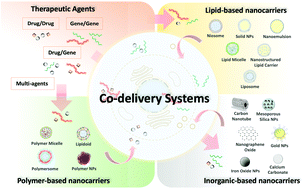Recent advances in co-delivery nanosystems for synergistic action in cancer treatment
Abstract
Nanocarrier delivery systems have been widely studied to carry unique or dual chemical drugs. The major challenge of chemotherapies is to overcome the multidrug-resistance (MDR) of cells to antineoplastic medicines. In this context, nano-scale technology has allowed researchers to develop biocompatible nano-delivery systems to overcome the limitation of chemical agents. The development of nano-vehicles may also be directed to co-deliver different agents such as drugs and genetic materials. The delivery of nucleic acids targeting specific cells is based on gene therapy principles to replace the defective gene, correct genome errors or knock-down a particular gene. Co-delivery systems are attractive strategies due to the possibility of achieving synergistic therapeutic effects, which are more effective in overcoming the MDR of cancer cells. These combined therapies can provide better outcomes than separate delivery approaches carrying either siRNA, miRNA, pDNA, or drugs. This article reviews the main design features that need to be associated with nano-vehicles to co-deliver drugs, genes, and gene–drug combinations with efficacy. The advantages and disadvantages of co-administration approaches are also overviewed and compared with individual nanocarrier systems. Herein, future trends and perspectives in designing novel nano-scale platforms to co-deliver therapeutic agents are also discussed.



 Please wait while we load your content...
Please wait while we load your content...